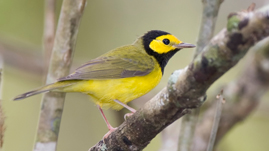Teachers' Domain - Digital Media for the Classroom and Professional Development
User: Preview


Hooded Warblers are one of many migratory species who spend the summer in one region, such as Natural Bridge in central Kentucky, then fly south to warmer climates for winter. Not only do these species make this trip each year, they can be evidence of the overall habitat health of a region. Adapted from the Kentucky Life Biodiversity series, this video explains why the Hooded Warbler is a sign a region can support different habitats.
Indicator species are species of plants, animals, or other organisms that help determine the overall condition of a region or area. They are significant because their presence indicates a balance in the ecosystem in which they are found, while their absence would negatively impact other species in the region. Scientists and researchers monitor these species to learn more about how certain natural and man-made changes in the environment could impact other species.
Every natural area has species that are more common than other species in that region. This is because different species of plants require different types of soil conditions. For example, a plant that requires moist acidic soil, will not survive in a region where the soil is dry and has a large alkaline component. If a plant species exists in a certain natural region, it’s because the conditions in that region are favorable for the plant to grow, thrive, and reproduce. If this species starts to suffer, it may be an indicator that the soil in the region has lost moisture or suffered in some way so that it cannot support this variety of plant. For this reason, we call certain species of plants, animals, and other organisms, “indicator species,” because they indicate certain natural factors are present or absent in a region.
The Hooded Warbler needs large tracts of forested area in order to survive and reproduce. Because it is a migratory species, spending the winter months in a warmer climate, the Hooded Warbler has a choice in where she will make her summer home. By monitoring the return of this species of warbler each year, the researchers at Natural Bridge State Park in Kentucky know there is enough healthy forested land to support them. And if the Hooded Warbler returns, it is likely other migratory species, requiring similar conditions, will return as well. In this way, the Hooded Warbler is an indicator species, indicating a region has suitable and sufficient habitat for certain types of migratory birds.
This is a Hooded Warbler. We have uh a bunch of different kinds of warblers in Kentucky. This is one that is pretty common in the Natural Bridge area, Red River Gorge area, you can find him on the Kentucky river, different places throughout the state.
We have an incredible diversity of near tropical migratory song birds in the state of Kentucky. He is just one of the dozens of species. Warblers are just pretty good indicators of the health of your forest. A lot of these birds really need intact large tracks of forested areas to survive. They are not necessarily what we would consider endangered, but many of them are a declining species. So, they are not doing that great, and it is mainly due to habitat loss. A huge number of our breeding.
Warblers use Natural Bridge and the Red River Gorge area, and they of course are almost the definition of neo tropical migrates. Many of them breed here in the summer, and they will fly all the way to Colombia, in some cases, and back every year. So, habitat loss at both ends is affecting them.
 Loading Standards
Loading Standards